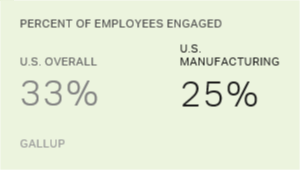Story Highlights
- 32.9% of U.S. employees "engaged" in workplace in February
- This is the highest monthly average recorded in three years
- The majority of U.S. workers are still "not engaged"
WASHINGTON, D.C. -- The percentage of U.S. workers engaged in their jobs rose from an average 31.7% in January to an average 32.9% in February. The latest monthly rate of employee engagement is the highest Gallup has recorded in three years and is a full 1 1/2 percentage points above where it stood in February 2014.

The February 2015 estimate is based on Gallup Daily tracking interviews conducted with 5,993 adults employed for an employer. Gallup categorizes workers as engaged based on their responses to key workplace elements that it has found predict important organizational performance outcomes.
Gallup began its daily survey of U.S. workplace engagement in January 2011. At its peak, the rate of U.S. employee engagement reached 33.8% in March 2011, followed by 33.6% in January 2012. Since then, monthly engagement has consistently averaged less than 33%.
Recent Engagement and Employment Trends Align
With only a third of U.S. employees engaged at work, half (50.3%) are "not engaged" and 16.8% are "actively disengaged." The slight gain in February engagement may be partially attributable to the nation's economic situation. As unemployment continues to dip and more workers find jobs, companies may be facing renewed issues with retention, leading them to put more emphasis on engagement as a way to keep their workers from seeking new job opportunities.
Recent trends suggest that improvements in engagement coincide with improvements in unemployment and underemployment.

Bottom Line
A decline in the percentage of unemployed and underemployed Americans may have some influence on the percentage of engaged workers. As the job market becomes more competitive, it is possible that companies are putting more effort into engaging their current workers. The slight rise in engagement may also be partly attributable to the workplace "honeymoon effect." Prior Gallup research indicates that newcomers to an organization are more highly engaged than tenured employees. And as more new employees join company workforces, they may be helping to move engagement up.
Although employee engagement made gains in February, its momentum appears to have slowed considerably. Engagement has stayed consistently below 30% for the first week of March. While the decline in engagement may in some part be the result of declining economic confidence, this dynamic tells only a portion of the story. Engagement is more highly dependent on factors inside the workplace, including manager talent and an organization's overall approach to employee strengths and development.
Employee engagement is a leading indicator of future business success, and Gallup has discovered close ties between engagement and outcomes such as turnover, profitability and productivity. As the percentage of their employees who are engaged at work increases, companies find themselves better positioned to grow. And when they grow, companies consequently help strengthen the economy.
Survey Methods
Results for this Gallup poll are based on telephone interviews conducted Feb. 1-28, 2015, on the Gallup U.S. Daily survey, with a random sample of 5,993 adults employed for an employer, aged 18 and older, living in all 50 U.S. states and the District of Columbia. For results based on the total sample of employed adults, the margin of sampling error is ±3 percentage points at the 95% confidence level. All reported margins of sampling error include computed design effects for weighting.
Each sample of national adults includes a minimum quota of 50% cellphone respondents and 50% landline respondents, with additional minimum quotas by time zone within region. Landline and cellular telephone numbers are selected using random-digit-dial methods.
Learn more about how Gallup Daily tracking works.

